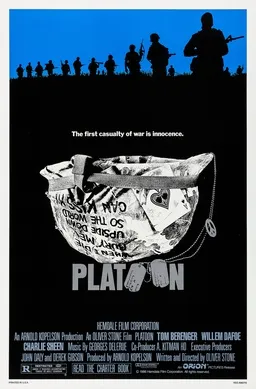Historical accuracy of Platoon

Historical accuracy of Platoon

Characters
Pvt. Chris Taylor
Represents writer-director Oliver Stone's own journey from a privileged background volunteering for Vietnam (1967-68), experiencing the war's brutality and moral complexities.
Sgt. Bob Barnes
Embodies the hardened, ruthless pragmatism and survival instinct forged by prolonged combat. Based partially on sergeants Stone knew, representing the dark, efficient side of warfare.
Sgt. Elias Grodin
Represents morality, compassion, and counter-culture influences (like drug use) within the war. A contrasting figure to Barnes, also based partially on sergeants Stone knew (from a different unit).
King
Represents the weary survivor focused on completing his tour and getting home, often offering cynical advice to newcomers.
Big Harold
Part of the ensemble representing the ordinary soldiers in the platoon. Forest Whitaker portrayed him.
Rhah
Represents soldiers who found different coping mechanisms or perspectives, often associated with Elias's group.
More characters
Bunny
Represents the potential for unchecked violence and cruelty among soldiers, particularly evident in the village scene.
Sgt. O'Neill
Represents poor leadership, careerism, and the failure of some NCOs under pressure.
Junior
Represents those soldiers who sought to avoid combat duty or shirk responsibilities.
Lt. Wolfe
Reflects the common reality of young, green officers commanding platoons, often heavily reliant on or overshadowed by experienced NCOs like Barnes and Elias.
Lerner
Represents soldiers with specialized roles within the infantry platoon. Played by Johnny Depp in an early role.
Captain Harris
Represents the level of command above the platoon, involved in directing operations but somewhat removed from the grunts' immediate experiences. Played by military advisor Dale Dye.
Story
New recruit's initiation into combat
Taylor's journey accurately reflects the harsh acclimatization process for new soldiers ("cherries") facing the jungle environment, combat realities, and platoon social dynamics.
Jungle patrols, ambushes, firefights
Widely praised by veterans for its realistic portrayal of the tension, chaos, fear, and sudden violence inherent in patrolling Vietnam's jungles and engaging the enemy.
Environmental challenges (heat, insects)
Realistically shows the constant struggle against the oppressive heat, humidity, monsoon rains, leeches, ants, and other environmental factors that plagued soldiers daily.
Internal platoon conflict (Barnes vs Elias)
Represents real ideological and philosophical clashes among soldiers, but the intense, polarized division into two warring factions within one platoon is likely amplified for dramatic storytelling purposes.
Drug use among soldiers (marijuana)
Depicts drug use (primarily marijuana in Elias's "Underworld" bunker) as a coping mechanism. While drug use existed, its prevalence and openness, especially near combat zones, is debated by veterans.
Village search / Atrocities
The disturbing village scene, showing potential for civilian killings, torture, and attempted rape, reflects the documented reality of atrocities committed during the war (like My Lai, though not depicting it specifically).
Moral ambiguity and ethical dilemmas
Effectively captures the erosion of traditional morality, the difficult choices soldiers faced, and the psychological impact of counter-insurgency warfare where distinguishing combatant from civilian was hard.
Fragging incident (Barnes kills Elias)
Fragging (murder of unpopular superiors) did occur in Vietnam. The specific depiction of Barnes killing Elias during combat is a dramatized event central to the film's moral conflict.
Ineffective / Inexperienced Leadership
The portrayal of Lt. Wolfe highlights the documented issue of young, inexperienced officers leading men in complex combat situations.
Chaotic final battle scene
Based loosely on Stone's experience in the New Year's Day Battle of 1968, it realistically portrays the confusion, intensity, high casualties, and breakdown of unit cohesion in a major engagement.
Taylor's killing of Barnes
Taylor's execution of the wounded Barnes represents a culmination of the film's internal conflict and Taylor's loss of innocence, rather than a typical historical event.
Experience of being wounded / evacuation
Shows the suddenness of being wounded and the process of being evacuated by helicopter ("medevac"), a common experience for many soldiers.
Setting
Vietnam War environment (1967-1968)
Filmed in the Philippines, the locations effectively mimic the jungles, heat, and humidity of Vietnam during the period Stone served. Use of imported red soil enhanced visual accuracy.
Firebases and base camp life
Represents the typical settings of forward firebases and rear base camps, including bunkers, tents, sandbags, and the general atmosphere of these locations.
US Army uniforms and equipment
Highly accurate depiction of uniforms (OG-107s, Tropical Combat Uniforms), M1 helmets with graffiti, webbing (LBE), M16 rifles, M60 machine guns, grenades, radios, and other period-correct gear.
Depiction of Vietnamese villages
Shows the basic structure (hooches) and appearance of rural Vietnamese villages that soldiers would have encountered.
Weather effects (heat, monsoon)
The film successfully incorporates the oppressive heat, humidity, and torrential downpours characteristic of Vietnam's climate, showing their impact on operations and morale.
Sound design in combat
Praised for its realistic audio, capturing the intense, overwhelming sounds of gunfire, explosions, and shouting during battles without excessive musical scoring interfering.
Historical timeframe (1967-1968)
Accurately set during a period of escalating US involvement and heavy fighting, reflecting the specific timeframe of Oliver Stone's own tour of duty along the Cambodian border.
